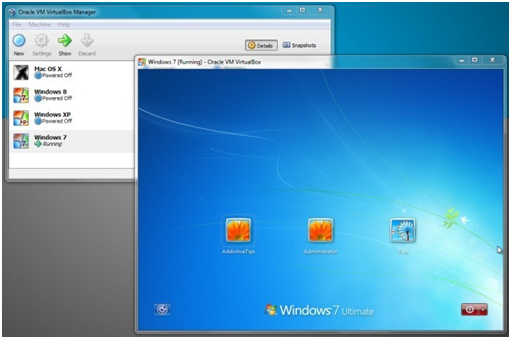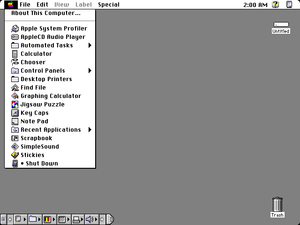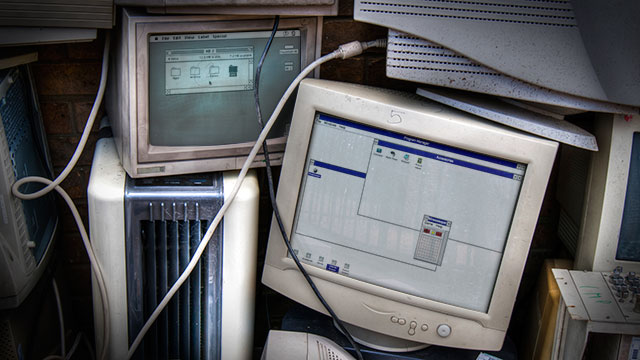Mac Os 7 Emulator
- Mac Os 7 Online
- Mac Os 7 Emulator
- Mac System 7 Emulator For Os X
- Mac Os 7 Emulator Online
- Mac Os 7 Emulator For Windows 10
- Mac Os 7 Emulator
All OldOs fans will know that there is little more satisfying than getting that old computer or Operating System up and running. What's even better than getting that old version of NT up and running is running an OS that shouldn't work; that wasn't intended to work on your hardware.
What's in this How-To?In this how-to, you be guided through the full process of setting upComplete desktops contain all operating system components as well as Internet Explorer and Outlook Express. Where possible, I have tried to include built in file transfer programs (Web Publishing Wizard, Web Folders), useful system tools (System File Checker, System Restore) and certain wizards (Network Setup Wizard, Internet Connection Wizard). The emulator environment is based on the open source PCE emulator.The published hard drives contain the entirety of a MacOS 7.0.1 system with HyperCard, BBEdit Lite, Mac Draw, and Mac Paint. What’s an Emulator? This is a piece of software, which lets a computer system act like another.
MacOS 7.5.3 and optionally the 7.5.5 update on Basilisk II, the freeware Mac II emulator designed by Christian Bauer, from scratch using only freeware, downloadable items. The end result will be a fully working MacOS system.Tools:To accomplish these tasks you will need to download the following sets of tools:
- Aladdin StuffIt Expander for Windows 5.0 (It is important to use a version such as this as the new version offered on Aladdin Systems website does not support the decompression of MacBinary files under Windows, and we will be doing that here)
- HFV Explorer (A free utility to use HFS volumes under Windows)
- Basilisk II Mac Emulator (Windows NT/9x Version)
- Install CD Image Part: (1)(2)(3)(4)(5)(6)(7)(8)(9)(10)(11)(12)(13)(14)(15)(16)(17)(18)(19)
- System 7.5.5 Update for 7.5.3, Disk: (1)(2)(3)
- iCab Net Browser (the only browser in development for 68k Mac's - it's fast and it's not MS :) )
- WinImage Trial Edition (This is only if you are a purist who prefers using slow floppy disks compared ultra-fast disk images ;) )
You can download a Mac Quadra 650 ROM here: Download. Note that you may only download the ROM if you have an actual Macintosh. Using the ROM without owning a Macintosh is illegal.
Method
1) Preparation:
Obviously, the first step is to download the files that are required and any optional extras you wish to use in your emulated or Macintosh system. Once you have downloaded all the files you will be using, follow the instructions below and you will soon be looking at the smiley Mac that either know and love, or will soon learn to love!
Install the applications for Windows, and create a directory to keep all the Apple files you will be using later.
2) Start Up Disk:
Run StuffIt Expander for Windows. You will be greeted with a screen like the one shown below.

Locate the file you downloaded earlier called 'Network_Access_Disk_7.5.sea.bin', and drag it into the StuffIt Expander Window. This will decompress the file and create a new directory below the one in which 'Network_Access_Disk_7.5.sea.bin' was stored. This will be called 'Network Access', and contains The Network Access Disk Readme and a file called Network Access.Image. It is the latter which we shall concern ourselves with.
2 a) Writing the Boot floppy;
To physically write a boot floppy for Basilisk II then use WinImage Trial Edition that you downloaded earlier. From the 'File' Menu, select 'Open'. Select to show all files in the dialogue at the base of the window. Open the newly made Network Access folder, and Select to open the 'Network Access.Image' file.
When you open this Image, NOTHING will be displayed in the WinImage Window, as shown below, DON'T WORRY ABOUT THIS. The Image is there.
From the disk menu, select to write a disk.
Insert a blank 1.44Mb floppy disk into the disk drive you gave ticked under the 'Disk' menu.
You have created your startup disk for a Macintosh Computer!
3) Preparing Hard Files for Basilisk II:
Open the program HFV Explorer from the folder you installed it to. Now, to format a new Hard Drive File for use in Basilisk II. For a start, lets format a 500 Megabyte Apple HFS Hard Drive. In the 'File' Menu in the HFV Explorer Window, select the option to 'Format New Volume'
The Options selected in the Picture above will create a new 'Hard Disk' for use in the Emulated Macintosh. The 'Mac' will see this as a 500Mb Hard Disk Partition named System7, whereas it is really a file, stored in D:system7.hfv. Get the picture? (NOTE: The volume names and file names do not have to match, I merely do this for the sake of consistency. For example, if you name the file the same as the volume name in the emulated environment, it is easier to keep yourself right when opening volumes in HFV Explorer.)
Locate all 19 parts of the System 7.5.3 Install CD Image you downloaded earlier. Copy all these items to your Macintosh Disk volume (System7 in this example by dragging them to it). It is a good idea to create folders from within HFV Explorer in the same way as you would in Windows Explorer, just to keep track of all the files. Copy all the Macintosh files you will be using later on at this point as well.
Help! I downloaded HFVExplorer and they won't copy for me, I just drag them into the disk but nothing happens, if anyone knows how to correct this e-mail me at borstalbreakout@gmail.com
When the above dialogue is shown, always select 'Automatic; let the program decide' and 'OK to All' as is shown above.
4) Configuring the Basilisk II Emulator:
Once you have unzipped Basilisk II to your chosen folder, open the program 'BasiliskIIGUI.exe'. This is the configuration utility for Basilisk II. Since Basilisk II emulates a a Macintosh system with a 68020, 30 or 40 Central Processing Unit, you will need a ROM file from one of these computers. You are only allowed to use a ROM from the computer you legally own. There are detailed instructions in the Basilisk Installation regarding dumping a rom from a real 68k Mac. There is a Quadra ROM available from the Downloads Section for Quadra owners only, and is provided for convenience only.
In the 'General' Tab:
set the Boot Driver to '0: Boot from first bootable volume'
Set the Model ID to '14 (Mac Quadra 900)' (No matter what ROM you are using, the Windows port of BII is optimized to use this model ID.
Set the CPU to 68040, and check the use of FPU Emulation.
In the 'Memory' Tab:
Set the RAM size to something that won't cripple your PC, but won't leave the Mac short either. 64 Mb is fine for most 68k work.
Click browse at the 'ROM file path' section to find your ROM file.
Information about the ROM will be displayed in the box at the base of the Window, if you 'Corrupt' or 'Unsupported', then you have incorrectly obtained the ROM from your Macintosh.
In the 'Screen' Tab:
Completely your preference. I always like to set the 'Colors' value to 16 bit or 32 bit though.
Next, move to the 'Disk' Tab:
Firstly, click on browse, enable all files in the file types field, and find the file 'Network Access.image'.
Next, find the Hard Disk File you created earlier.
Set the Network Install Image to hive higher boot priority by putting it up the list.
Your end result should appear similar to this:
Go to the floppy and CD tabs to configure which of your host PCs removable disks you want to use in the same manner.
We are now ready to boot the Emulated Mac.
5)First Boot
When you boot your Macintosh for the first time, the best thing to do is to copy the system folder from the Network Access disk Image to your System hardfile.
You can then, if you chose to do so, shut the Mac down from the special menu, and the remove the Network Access Disk from list of installed disks in the BII GUI program. This will serve to make things slightly tidier, and also test if your copy of the System Folder was successful.


When you restart, you are now ready to install System 7.5.3.
Open up the folder in which you imported the 19 Installer part images. In my example, this folder was called 'System 7 Installer'
Double-click to open the first part (the Self Mounting Image or .SMI file).
Agree to the terms of the license. This will mount the image of the CD Installer on the desktop.
Double click to open the CD Image.
You are now ready to install The System Software. You will be greeted with a screen like this one:
From here on in, it is pretty much follow the bouncing ball. However, you should make sure that installation disk is selected as the one you wish to use in BII. Also Select Custom Install. My Setup looked like this:
Chose the components you want to install. I chose pretty much all, except A/Rose under Networking and Extensions, as BII is incompatible with this.
When you have installed the system reboot the 'Mac'.
IMPORTANT NOTE: If you wish to install the Macintosh System 7.5.5 update YOU MUST chose 'Easy Install'. There is a bug in the Emulator which causes any custom or other types of installs to fail when updated to 7.5.5.
HOORAY!:
6) Configuring the System
You can now start to install all the optional software you like.
If you are installing The System 7.5.5 Update, it is best to do it now, when there are no applications installed on the system.
To install the Update, you will also need the Disk Copy Application listed above.
Locate the DiskCopy Image and open it. This will mount a floppy disk called Disk Copy onto the dekptop.
Open that image.
Copy the lower file onto the desktop, you will get a warning about a locked disk most likely, this is referring to the disk image. Just click OK.
Now, go to the folder with the update disk images, there are three self extracting archives. Open them all.
You should now have something very similar to the above set up. Drag the three files on the bottom row to the Disk Copy Application we moved to the desktop before.
NOTE: You can again, create update disks to use on a real Mac or for reference. Format three floppies to Mac 1.44Mb and simply copy the contents of the three images shown above to the three diskettes.
Open up the 'disk' Update - 1' and double click on the installer. This will automatically update the system to 7.5.5
CONGRATULATIONS:
The groundwork is now done for making your Macintosh System. The OS is set up and you have a number of Applications installed.
Please visit the download section of OldOS for more high quality Macintosh freeware and abandonware programs updated regularly. :)
- Categories: Apple - HowTo - MacOS - Microsoft - Windows
Be over your best web hosting hunt with cheap virtual private servers and exclusive dedicated servers.
Listed on this page are Macintosh emulators: some of them emulate a 68k Macintosh (such as what you get inthe Macintosh Quadra, Performa, Classic, etc), others emulate a PowerPC Macintosh. Note that if you are usinga 68k Mac emulator and wish to run Mac OS (such as System 7.5.5, etc), you will need to havea real Mac around somewhere since such systems require you to have a Mac ROM. (the various emulators usually provide you with instructionson how you can make a copy of the ROM from your real Mac).
At present, I know of no software emulator that can emulate an Intel x86 Macintosh or to run OS X in a virtual machine on a PC.
Note: if you are looking for an emulator or virtual machine that runs on a Mac and allows you to emulate a PC, running operating systems like Windows,you should try the Free x86 PC Emulators and Virtual Machines page instead.If you prefer the features, speed and completeness of support of a commercial software, take a look atParallels Desktop for Mac.
Skip directly to[ Power PC Mac Emulators ] |[ 68k Mac Emulators ]
Related Pages
- Free x86 PC Emulators and Virtual Machines - emulate a PC to run multiple OSes
Free PowerPC (PPC) Mac Emulators
QEMU supports the emulation of x86 processors, ARM, SPARC and PowerPC. Host CPUs (processors that can run the QEMUemulator) include x86, PowerPC, Alpha, Sparc32, ARM, S390, Sparc64, ia64, and m68k (some of these are still indevelopment). When emulating a PC (x86), supported guest operating systems include MSDOS, FreeDOS, Windows 3.11,Windows 98SE, Windows 2000, Linux, SkyOS, ReactOS, NetBSD, Minix, etc. When emulating a PowerPC, currently tested guest OSesinclude Debian Linux.
SoftPear is a compatibility layer that allows you to run macOS on PC (x86) hardware. It works by dynamicallyrecompiling Mac programs (including Mac OS X) into x86 binary code that runs on your PC, and adding a layer thattranslates things like endianness.
Mac Os 7 Online
This is essential a virtual machine that allows you to run macOS on top of a Linux host system that runs on a PowerPC computer.Supported host CPUs include the PowerPC 603, 604, G3 and G4. It also allows the use of AltiVec in the Guest OS if the CPU supports it. At the timethis was written, only PCI devices (hard disks, USB drives, CDROM and DVD drives, etc) that do not use DMA are natively supported.
SheepShaver allows you to run classic MacOS applications on BeOS and Linux. It includes a PowerPC emulator which isused if you are using a non-PPC system. It supports MacOS 7.5.2 to 8.6 as the guest operating system, a colour display,internet and LAN networking via Ethernet, serial drivers, SCSI Manager emulation, file exchange with the host OS,access to floppy disks, CD-ROMs, HFS(+) partitions on hard disks, sound, etc.
Mac Os 7 Emulator
PearPC emulates a PPC (PowerPC) Macintosh, allowing you to run Darwin PPC, macOS and Linux in the emulated machine.Supported hosts include Windows and Linux (and possibly other Unix-type systems).
Mac System 7 Emulator For Os X
Free 680x0 (68K) Macintosh Emulators

The Advanced Mac Substitute is able to run 68K Mac applications without an Apple ROM or MacOS. It does this byreimplementing the API (that is, the programming interface) of the classic MacOS. The emulator runs onmacOS and Linux. The program is released as source code, so you will actually compile it intobinary (ie, executable) form before you can run it.
Mac Os 7 Emulator Online
PCE/macplus is an open source emulator for theMacintosh 128K, Macintosh 512k, Macintosh 512ke, Macintosh Plus, Macintosh SE and Macintosh Classic.It emulates the MC68000 microprocessor with RAM configurations from 128 KB to 4 MB. Precompiledversions of the emulator, including the ROM image and operating system software, that runs on Windows,are available. The C source code is released under the GNU General Public License. This is the Mac emulatorcurrently used by the Internet Archive for theirMacOS System 7.1 Compilation.
Mini vMac is an emulator for the Macintosh Plus and Macintosh SE. There are versions for Windows,Mac OS X, Mac OS 9 (PowerPC), Linux (x86), Pocket PC, and Macintosh 680x0. The source code is releasedunder the GNU GPL.
Basilisk II/JIT is an adaptation of the original Basilisk II Macintosh emulator (see elsewhere onthis page) to includea just-in-time (JIT) compiler (presumably speeding up the emulated machine). Host platforms include Linux/i386,FreeBSD/i386 and Windows. Guest OSes include the 68k Mac OS. Basilisk II/JIT is open source.
The Basilisk II Mac emulator allows you to emulate a 68k Macintosh on a variety of platforms, including BeOS (PowerPCand x86), Unix with X11 (including Linux, Solaris 2.5, FreeBSD and IRIX), AmigaOS 3.x, and Windows. The emulator isable to emulate a Mac Classic or Mac II depending on the Mac ROM you use (not included). Your emulated Mac has a colourdisplay, CD quality sound output, floppy disk drive, HFS partitions and files, CDROM drive, etc. You can easily movefiles between your host system and the emulated machine. Basilisk II is open source.
Mac Os 7 Emulator For Windows 10
SoftMac is a 68k Macintosh emulator that runs under Windows. Fusion PC emulates a 68k Mac on MSDOS systems. Note thatin spite of what the website and software claims, I have never been able to get sound working on SoftMac (nor have,apparently, anyone else I know). You will need a Mac ROM for the emulator to work.
- How to Register Your Own Domain Name - how to get your own domain name
Mac Os 7 Emulator
It will appear on your page as: